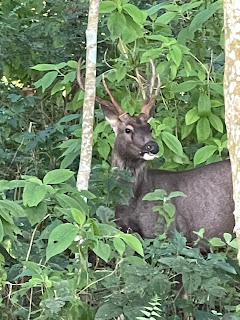Farewell, Nepal.
I’m safely home - it was an interesting journey. Priority was given, rightly, to getting relief supplies to the earthquake area; I’m not so sure that the international media, having taken their disaster photos, should have been able to barge their way into flights home. But I’m back.
And before I came back? I made it to Bardia - a national park in the south-west. It’s hard to reach, and so far away from the main tourist trail. Animals are less disrupted by the army of jeeps that career around Chitwan. It’s easier to see tigers …
These footprints were made by a tiger about an hour before we passed on the jeep. Shall we follow on foot? Let’s not. I’ve been too close to a tiger before and it’s an excitement I don’t need to repeat. Though we did see fairly fresh tiger poo further down the path, so the chances are he’d eaten and might not be looking for another dinner quite yet.
Sorry, no photo of tiger poo. The things you can learn from poo! Rhinos stand still to poo while elephants can do it while they trundle along the path. And langur monkeys (like howler monkeys) think it’s funny to pee on tourists who stop under their tree to take photos. (You will understand why I didn’t hang about with my camera.) Eagles, however, are more interested in searching for unsuspecting rodents.
For me, the quiet of Bardia was the point. We stopped for lunch with a view over a blue river, wending its warm way along a sandy valley. No river dolphins, no rhinos coming to drink. Just the heat and the dust and the chirrup of crickets. After lunch we paused by countless watering holes like this - some of my fellow travellers on the jeep were disappointed there were no animals coming to drink, only that wet woodland smell with a hint of animal. But frogs leapt about in the shallows, and the reflections clear and glittering.
I could have lingered, but with 30 day visa my time was almost up. Back in Kathmandu I had one day to potter about before coming home.
Kathmandu was devastated by the earthquake in 2015. The city itself appears to have recovered: markets are thriving, streets are clogged with motorbikes, festivals (Dashain and now Diwali) are celebrated with as much joy as ever. But looking closely … not all the temples in Durbur Square are fully restored. There are still heaps of rubble and buildings hidden behind scaffolding. And, in the corners where people are living, some buildings have been beautifully restored and look down on grateful shrines, while the homes next door are still leaning on props to stop the building collapsing.
And so I’m home. I have clean water and predictable traffic and shops full of Christmas razzmatazz. Back in Nepal they are lighting candles for Diwali. It will take me a day or few to relocate myself.



















